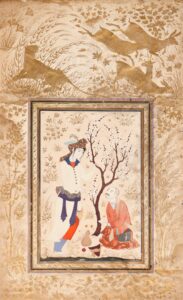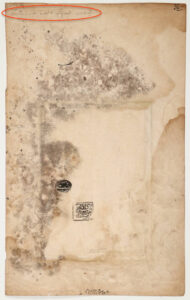 The Rijksmuseum has acquired a unique Persian miniature with a Dutch inscription that dates to the early 17th century. The Dutch handwriting on the back marks the miniature as the earliest known example of Persian art in the Netherlands.
The Rijksmuseum has acquired a unique Persian miniature with a Dutch inscription that dates to the early 17th century. The Dutch handwriting on the back marks the miniature as the earliest known example of Persian art in the Netherlands.
The miniature is 6.9 by 4.6 inches and features a central panel of a stylishly attired young man standing near a tree. A mendicant dervish sits on the ground looking up at him. A frame is drawn in around it and on the other side of the frame is a wide border of gold flowers, plants and birds. Across the top a herd of deer leap away from a hunting tiger.
The drawing was made by a still anonymous artist in Isfahan. On the back of the leaf are two Iranian cancels with the dates 1620/21 and 1630/1. The miniature therefore dates from the time of Shah Abbas the Great (1586-1628). This period is considered the pinnacle of Safawadic art.
These were the earliest days of Dutch engagement with Iran. Abbas had been the first Safavid Shah to make contact with European powers seeking allies against the Ottoman Empire. The first treaty between the Dutch East India Company and Iran, a deal to trade silk, was signed in 1623.
 On the back is an inked inscription that reads “kalawat en sijne mat,” but its precise meaning is unknown. It does appear in Indonesian literature as the world for prince, and “mat” was an abbreviation for “majesty.” Rijksmuseum researchers believe the inscription is a curatorial note, evidence that the miniature was part of a Dutch collection shortly after it was made.
On the back is an inked inscription that reads “kalawat en sijne mat,” but its precise meaning is unknown. It does appear in Indonesian literature as the world for prince, and “mat” was an abbreviation for “majesty.” Rijksmuseum researchers believe the inscription is a curatorial note, evidence that the miniature was part of a Dutch collection shortly after it was made.
Only four other Iranian miniatures with an old Dutch inscription are known. Two of these are also in the collection of the Rijksmuseum. But all four are probably from around 1700 and of a much lesser quality. They may even be specially made for foreign travelers as a souvenir. The miniature that the Rijksmuseum has now acquired is not only of a much higher quality, but also almost a century older.
—
“On the back is an inked inscription that reads ‘kalawat en sijne mat,’ but its precise meaning is unknown. It does appear in Indonesian literature as the world for prince, and “mat” was an abbreviation for ‘majesty.'”
—
“Kalawat” is a district in the North Minahasa Regency in North Sulawesi, the island formerly known –particularly to the Dutch– as “Celebes”. A Portuguese base was installed in Makassar in the first decades of the 16th century, lasting until 1665, when it was taken by the Dutch. The Dutch had arrived in Sulawesi already in 1605.
In the Cebuano that is spoken in the Southern Philippines, “Kalawat” also means the communion wafer, i.e. the sacramental bread used as the Eucharist host, unless they cut off your entire head that is.
“Mat”, however, could –even in Dutch– mean what it really is, ‘mattress’ (not to be confused with ‘madrassa’). For Abbas, it seems, things like wine and young tender cupbearers played a certain role. As far as his own princes were concerned, he apparently had no choice but to have them –well– being cared for.
Are those folks the exactly same ones in the following –maybe not so unique– 17th c. Persian miniature? -Cf.:
upload.wikimedia.org/wikipedia/commons/9/9b/Shah_Abbas_and_Wine_Boy.jpg
——-
PS: For other uses of “Mat”, cf. матерщи́на / ма́терный язы́к, and here the “four pillars”:
wikipedia.org/wiki/Mat_(Russian_profanity)#Four_pillars_of_mat :skull: